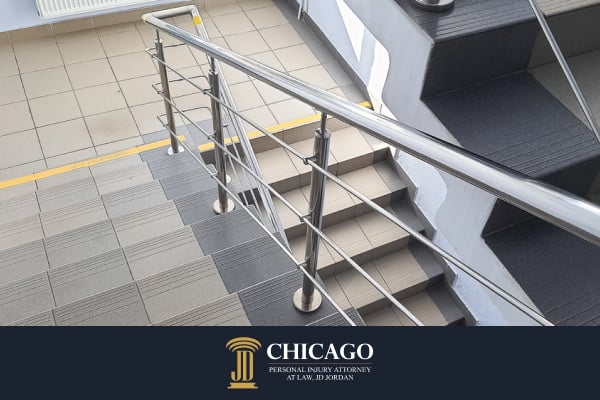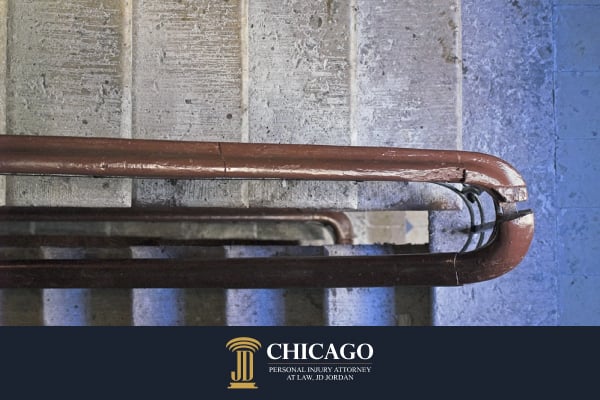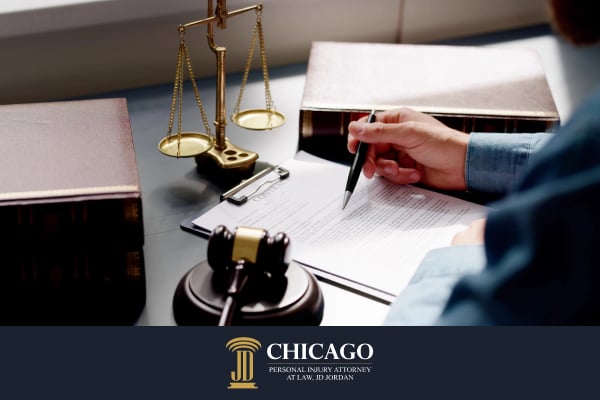



A Chicago broken stairways accident lawyer understands that structural deterioration and physical damage to existing stairway systems create urgent safety hazards that property owners must address immediately to prevent serious injuries. Broken stairways result from age-related deterioration, weather damage, deferred maintenance, physical impact, or structural overloading that compromises the integrity of steps, handrails, and supporting structures. Chicago's harsh weather conditions, including freeze-thaw cycles and salt exposure, accelerate stairway deterioration and create ongoing maintenance challenges for property owners.
At JD Jordan Law, our talented law firm has successfully represented numerous clients injured by broken stairway conditions, holding negligent property owners accountable for their failure to maintain safe premises.
[ez-toc]
Our Chicago broken stairways accident lawyer specializes in premises liability cases involving structural failures, maintenance negligence, and emergency repair obligations that property owners often ignore until serious accidents occur. These cases focus on proving that property owners knew or should have known about dangerous, broken conditions but failed to take reasonable steps to repair the hazards or protect visitors from harm.
Premises liability law requires property owners to maintain their structures in reasonably safe condition, and broken stairways often represent clear violations of this fundamental duty. Our legal team investigates how long the dangerous conditions existed, what the property owner knew about the problems, and whether they took adequate steps to protect visitors while arranging for repairs. We work with structural engineers and safety experts to document the extent of the damage and establish how the broken conditions directly caused your injuries.
Concrete stairways commonly develop cracks, spalling, and crumbling, which create tripping hazards and unstable walking surfaces that require immediate professional repair or replacement. Wood stairways are prone to rot, warping, and structural weakness due to moisture exposure and age, while metal stairways are susceptible to corrosion, rust, and connection failures that compromise their load-bearing capacity. Foundation settlement can cause entire stairway systems to shift, creating dangerous gaps and uneven surfaces.
Chicago's extreme weather conditions accelerate stairway deterioration through freeze-thaw cycles that crack concrete and masonry, while the application of road salt causes rapid metal corrosion and damage to the concrete surface. Water infiltration from poor drainage or damaged weatherproofing allows moisture to penetrate structural elements, causing rot in wood components and corrosion in metal supports.
The Illinois Department of Public Health recognizes environmental factors as significant contributors to fall hazards that property owners must address through proper maintenance and weatherproofing programs. Regular inspection and preventive maintenance can identify weather-related damage before it reaches dangerous levels.

Illinois law establishes clear obligations for property owners to address broken stairway conditions promptly and provide adequate protection for visitors until permanent repairs can be completed. These duties include immediate hazard assessment, emergency protective measures, and reasonable repair timelines based on the severity of the dangerous conditions. Property owners cannot simply ignore broken stairways or delay repairs indefinitely without facing liability for resulting injuries.
The two-year statute of limitations for personal injury claims underscores the importance of taking prompt legal action in the event of a broken stairway accident. Evidence of the broken conditions, the property owner's knowledge, and inadequate response can be lost or destroyed if an immediate investigation doesn't preserve crucial documentation and witness testimony.
When stairways develop dangerous, broken conditions, property owners must immediately assess the safety risks and implement protective measures to prevent accidents while arranging for professional repairs. This includes installing temporary barriers to prevent access to dangerous areas, providing adequate warning signage, and arranging for alternative safe routes when possible.
Property owners must arrange for competent professional repairs that restore stairways to a safe, code-compliant condition within reasonable timeframes, based on the severity of the damaged conditions. Minor repairs can often be completed quickly with temporary protective measures, whereas major structural damage may require extended repair periods and comprehensive alternative access arrangements.
Professional repair work must comply with current building codes and OSHA safety standards to ensure the restored stairways provide long-term safety for all users. Property owners who attempt inadequate temporary repairs or ignore underlying structural problems remain liable for future accidents.

Broken stairways present various dangerous conditions that can cause serious fall injuries depending on the type and extent of structural damage involved. Common types of failures we see include:
These structural failures often develop progressively but can suddenly reach critical failure points, making regular professional inspections and prompt repairs essential for preventing serious accidents and catastrophic injuries.
Broken stairways create life-threatening risks that require immediate attention from property owners to prevent serious accidents and potential fatalities. The combination of structural instability, sharp debris, and unpredictable failure modes makes broken stairways among the most dangerous premises liability hazards encountered in Chicago buildings. Common examples of dangers we see include:
Height factors significantly influence injury severity potential in broken stairway accidents, with falls from upper floors presenting greater risks of traumatic brain injuries, spinal cord damage, and fatal injuries. Environmental conditions, including lighting, weather, and user traffic levels, affect accident likelihood and severity outcomes. User vulnerability considerations include age, physical limitations, and familiarity with the building layout.
Professional risk assessment helps property owners understand the immediate danger levels and appropriate protective measures needed to prevent accidents while arranging for permanent repairs. Wrongful death lawyers often handle cases where broken stairway conditions result in fatal accidents that could have been prevented through proper maintenance.
Broken stairways often compromise building egress routes, which are essential for fire safety and emergency evacuation, resulting in serious code violations that must be addressed immediately through alternative route arrangements. ADA compliance issues arise when broken stairways eliminate accessible routes for disabled building users, requiring temporary accommodation measures during repair periods.
Building codes require multiple egress routes in most structures, and broken stairways that compromise these safety systems create liability for property owners beyond simple premises liability concerns. Emergency responders must also be notified when broken stairways affect their ability to access building areas during emergency situations.

Documenting broken stairway conditions requires immediate action to preserve crucial evidence before repairs, weather, or other factors alter the accident scene. Common examples of evidence we look for include:
This comprehensive evidence collection approach ensures that all aspects of property owner negligence are thoroughly documented for maximum compensation recovery and accountability.

Broken stairway accidents often result in serious injuries requiring extensive medical treatment, rehabilitation, and long-term care due to the violent impact forces and unpredictable failure modes involved in structural collapses. Examples of compensation we can pursue on your behalf include:
Our legal team works with medical experts, economists, and life care planners to fully document all current and future losses for comprehensive compensation recovery that addresses your complete needs.
Seek emergency medical care first, then document the dangerous condition with photos if it is safe to do so, while preserving the broken elements that caused your fall. Report the incident to the property owner immediately and gather contact information from any witnesses to preserve crucial evidence for your potential claim.
Property owners have a duty to regularly inspect their premises and should reasonably discover any obvious structural problems through the exercise of reasonable care. Courts may find constructive notice when dangerous, broken conditions exist for a sufficient period that proper inspections would have revealed them, especially when the damage is visible and progressive.
Simply placing caution tape may not absolve property owners of liability if the barriers are inadequate, easily bypassed, or do not provide safe alternative access routes. Property owners must ensure temporary safety measures actually prevent access to dangerous areas and provide reasonable alternatives for building users.
While property owners aren't liable for natural weather accumulation, they remain responsible for underlying structural defects that weather conditions may worsen or reveal. Broken stairs that become more dangerous due to ice, snow, or rain still represent the owner's fundamental failure to maintain safe structural conditions.
Both landlords and tenants may share responsibility depending on lease terms, the location of the broken stairway, and who has maintenance obligations for different building areas. An attorney can help determine whether the landlord's duty to maintain common areas or specific tenant responsibilities apply to your particular situation and building layout.

At JD Jordan Law, we understand the urgent nature of broken stairway cases and provide immediate case evaluations to preserve crucial evidence before repairs eliminate proof of the dangerous conditions that caused your accident. Time is critical in these cases because property owners often repair dangerous conditions quickly after accidents occur, potentially destroying important evidence of their negligence and the extent of structural problems. Our experienced premises liability legal team knows how to document broken stairway conditions thoroughly and build compelling cases for maximum compensation recovery.
Contact us today to schedule your free consultation, and let us help you hold negligent property owners accountable for their maintenance failures.
